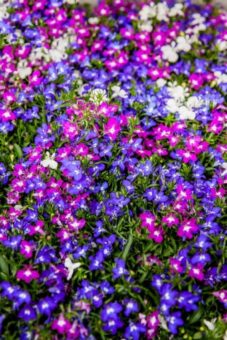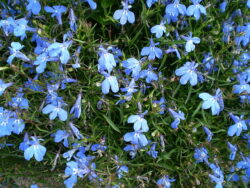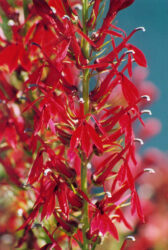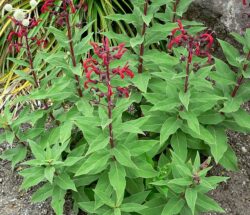In this article, we will discuss how to grow the beautiful and colourful trailing bedding plant of Lobelia in containers. They are a mainstay of hanging baskets and tall plant pots, where the deep blue, red, white or purple flowers are allowed to cascade over the edge.

These tend to blend well with the red, white, orange and yellow Begonias and showy pansies. The flowers that are often used are based on the half-hardy annual called Lobelia erinus, where some varieties are trailers, whilst others are more compact.
The annuals are not the only plant in the species as there are tender perennials. They all originate from South Africa.
The varieties will be described later but now we will learn how to grow Lobelia and how to get the best from them.
GROWING LOBELIA IN CONTAINERS
You have two options when growing Lobelia; either from seed especially the annual Lobelia, whilst the annual Lobelia and perennial Lobelia can be grown from shop-bought specimens.
No matter what you choose they tend to grow in full sun or partial shade, especially so for the annual varieties.
GROWING LOBELIA FROM SEED
In February or March, fill a seed tray with a good quality seed compost and water it until it emerges from the drainage holes. As Lobelia seeds are fiddly to handle, it will be better to mix them with some silver sand or buy pelleted seeds. On top of the compost, sprinkle the silver sand and seed mix so that a thin layer is generated. Do not add any more sieved compost as the silver sand will be sufficient. Cover the seed tray with a propagator lid and place it in a heated propagator or on a heat mat. This is because high temperatures are required for germination (between 18 to 24 degrees Celsius).

Once the seeds have germinated and allowed to grow on and once they are big enough to handle, you can prick them out in clumps of 4 to 6 seedlings (they do not have to be thinned out any further) to be transplanted into 24-cell plants full of multipurpose compost. They should be allowed to grow on, before hardening off in Mid-May before planting out in pots after the last frosts in late May.
At this stage, home-reared young plants grown from seed and shop-bought plants can be treated in exactly the same way. When buying shop-bought Lobelia erinus, make sure they are not in flower as this indicates that the plant is root-bound. This will make them difficult to transplant and successfully as it is difficult to get them to establish.
GROWING ANNUAL LOBELIAS
Choose a hanging basket or pot that has plenty of holes in them to allow the excess water to drain away. To this ass plenty of multipurpose compost to which a sprinkle of slow-release fertilizer has been added. To help retain moisture, which is very important for Lobelia, you can add some water-retaining gel.
Dig holes in the growing media at least 10 cm to 15cm apart that is slightly bigger than the original root ball. Place the plants in so that the top of the root ball is at the same level as the top surface of the compost. Backfill with the growing media, ensuring that any gaps that remain are filled with more compost. Firm the plants in and water well.
GROWING PERENNIAL LOBELIAS
To grow these, use a bigger container that is at least 20 to 30cm in diameter that has plenty of drainage holes. To this add a mixture of 70% by volume of multipurpose compost with 30% by volume of well-rotted manure.
Dig a hole that is slightly bigger than the root ball and place the plant inside so that the top of the root ball is at the same level as the top surface of the compost. Backfill it with the growing media, ensuring that no gaps remain. Firm the plant down and water well.

As said early annual Lobelias do better in partial shade, whilst perennial may do better in full sun. As the plant loves moisture then you will need to water regularly, otherwise, the plant will die back. If you did not add any slow-release fertilizer at planting, you will need to feed every 2 weeks with a general liquid fertilizer until it starts to flower. At this stage, you can switch to high potash, liquid fertilizer to promote masses of blooms. In Midsummer, when the plants may look tender, you can give the plant a gentle cutback to promote bushy growth and to encourage repeat flowering.
Perennial Lobelias will need to be kept moist at all times. Feed with a general balanced liquid fertilizer in spring and early summer until the flower buds start to appear. At this stage, it is advised that you switch to a high potash fertilizer at Midsummer. Once the flowers fade, you can cut them back along with the tired foliage, close to the ground. Not all perennial Lobelias are hardy, as Lobelia tupa will need its crown to be covered with mulch in autumn to protect the plant.
PESTS AND DISEASES
The main problem is that young leaves are attacked by slugs and snails, especially so for the perennials. It is advised that you protect young plants by using slug pellets or wool deterrent matting.
In cold, wet winters the crown may rot. If this occurs, it is best to bring your container plant under the protection of a greenhouse or conservatory, or you can expect losses.
They are also prone to wilting if the soil is not damp enough. It is important that you maintain consistent moisture throughout the growing season.
VARIETIES TO GROW
The annual Lobelia is exclusively based on Lobelia erinus, where many varieties exist. This includes the ‘Cascade Series’ that include the pastel shades of ‘Lilac Fountain’ and ‘Regalia Blue’.

The other varieties include ‘Sapphire Cascade’ that has blue flowers with white centres.
Compact varieties include the blue flowering ‘Cambridge Blue’ and the dainty ‘Crystal Palace’ that go well with Busy Lizzies and Mimulus. An intriguing double rosebud flower is ‘Kathleen Mallard’.
Perennial include the hybrid Lobelia x speciosa ‘Scarlet Fever’ that has bronze-green leaves and spikes of red-scarlet flowers. This is often grown as a biennial.
Lobelia tupa (Devil’s Tobacco) is an unusual perennial that has deep red-purple stems with blood red, tubular flowers.
Lobelia cardinalis ‘Queen Victoria’ has elegant leaves and from August to October spikes of dark red flowers appear.
Another suitable one to grow is Lobelia ‘Compton Pink’ has pale pink flowers that are darker in the centre. This perennial has an upright growing habit.
Lobelia siphilitica (Blue Cardinal Flower) is a perennial that has tall spikes of brilliant blue flowers.
CONCLUSIONS
In this article, we have discussed how to grow the annual and perennial Lobelias in containers. They are not only useful in hanging baskets but the perennials make great colourful plants in a cottage garden container display. They are easy to grow, easy to look after and pleasing to look at.
If you have any questions or comments that you wish to make on growing Lobelias in containers, please do so in the comment box below.
Happy Lobelia growing.
